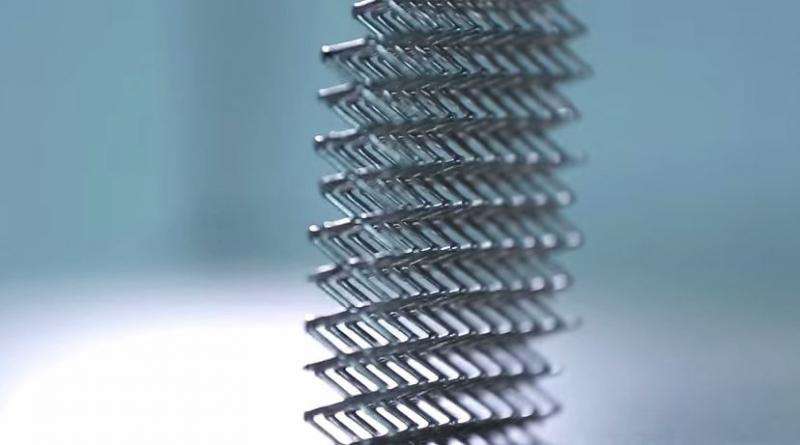October 15, 2015 report
Boeing demonstrates lightest metal ever

(Phys.org)—Airplane maker Boeing has unveiled what it calls the "The Lightest Metal Ever"—called microlattice, the material is a construct that is 99.99 per cent air. It has been developed by Boeing's HRL Laboratories along with colleagues at the University of California and the California Institute of Technology. The material has been developed as a way to reduce weight on airplanes or even rockets—a paper describing the development of the material was written by the team and published in the journal Science back in 2011—though the researchers have not yet revealed what sort of changes have been made since that time.
The more an airplane weighs, the more fuel it uses during takeoff, while flying and during landing, thus efforts to create lighter materials to replace those already in use have been underway for quite some time. The development team has released a video of the new material (in which they refer to it as a 3D open cellular polymer structure) in action—demonstrating its lightness by placing a rectangular cuboid atop a dandelion. The team also points out that the material also has a high degree of absorption, which means it can be depressed and bounce back—another feature that would come in handy on airplanes.
It appears at this time that Boeing is hoping the material can be used inside the cabin, rather than as a major structural component, e.g. in overhead bins, under the floor, or in other fixtures that are used to create an environment inside of a modern aircraft.
In the earlier paper the researchers described making the material first by creating a template and then by coating it with electroless nickel plating—afterwards the template was removed via etching. The result was a material that got its strength from the lattice, similar to the way bones grow to be strong despite being light, though with the lattice it is taken down to the micro scale—the lattice was a network of extremely tiny tubes with walls that had a thickness of just 100 nanometers, all made of a nickel-phosphorus alloy, though it is still not clear if the same materials were used in the newly updated microlattice.
The team at HRL suggest that the material could also eventually make its way into space-bound vehicles, for the very same reasons it would be useful in aircraft, to save on weight—plus its ability to compress might mean sending up objects that could be expanded after launch, saving on space in a cargo hold.
More information: www.boeing.com/features/2015/1 … est-metal-10-15.page
Journal information: Science
© 2015 Phys.org



















